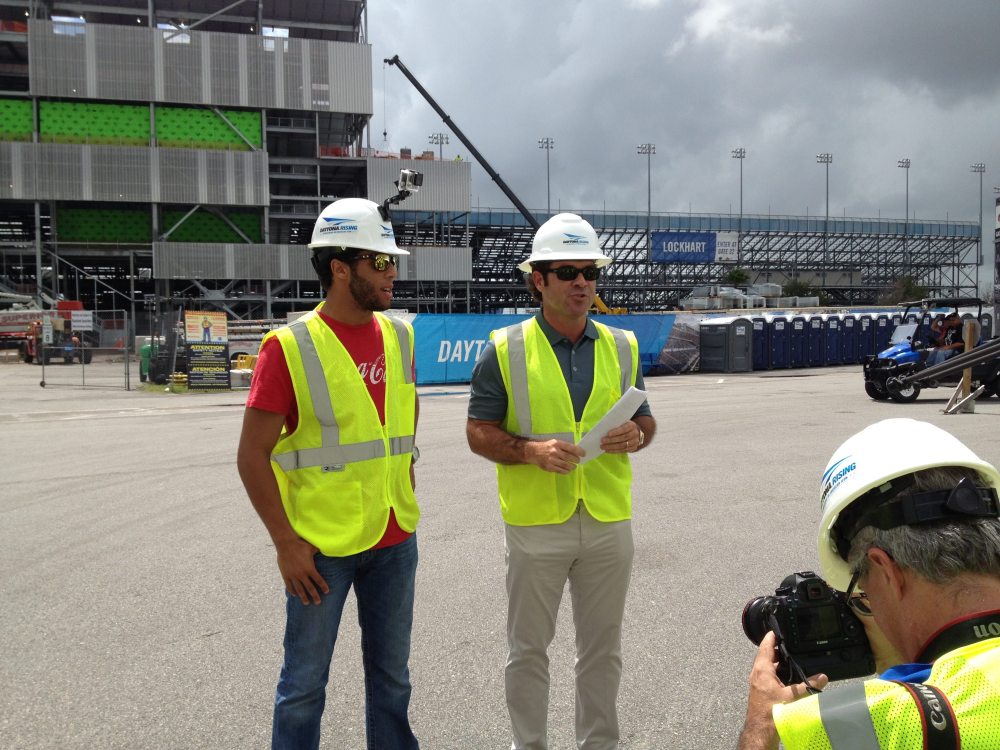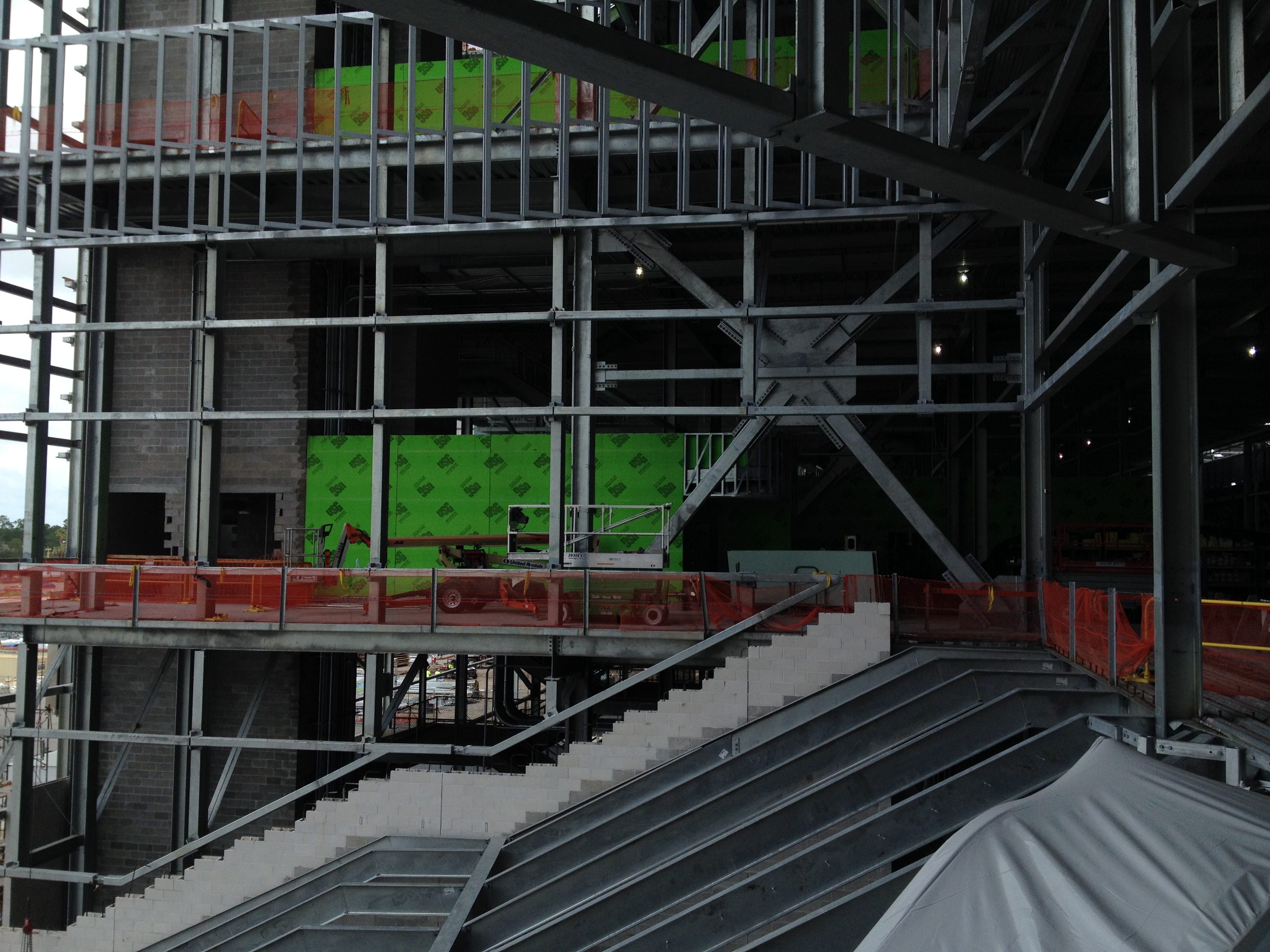When I visited the construction site at the Daytona International Speedway earlier this month, I, along with the other media, had to climb six flights of stairs up to the highest seats.
Having also recently climbed the last six stories of the Empire State Building to the observation lounge, I can report that the Speedway’s steps are slightly easier. But only slightly.
That’s all about to change as part of the new $400 million stadium construction. I detailed that construction in my first post about my visit to the Speedway in Daytona Beach, Florida.
This is about what it will be like to be in attendance once the stadium is finished.
Brandon McNulty, the Chief Technology Officer of the International Speedway Association, the parent company to Daytona International Speedway, is in the midst of plans to make the new stadium the most interactive to date, with social areas/neighborhoods throughout the concourses, free wifi, and RFID technology to tailer the experience to each attendee.

You’ve seen the commercial where the fan buys an NFL ticket and when he goes to the game, everything is tailored to “Gary?” That’s the idea the Speedway is striving to make a reality.
Why all this? And if you’re not a NASCAR or race car fan, why should you be interested?
The best comparison I can make is to another Florida destination: DisneyWorld, except instead of Walt Disney, the original driving force of Daytona International Speedway is founder Bill France Sr. It was his vision of a track to replace the beach racing that had been part of the beginning of the automative age.
Joie Chitwood III, President of Daytona International Speedway, wants to make the new stadium an experience to satisfy the hardcore and loyal race fans but also expand the audience for to all sports or event fans, like the fans who come to the Superbowl for the experience, not necessarily to root for a team. Add that to a planned entertainment complex just across the street from the Speedway, which will be analogous to Downton Disney, and Daytona Beach becomes the place to go for anyone remotely interested in racing.
And unlike the Superbowl, there are events at the Speedway year-round already, and Chitwood is looking into more when the stadium is finished, such as NCAA Division I football games.
First, the physical changes for attendees.
Right now, when it rains, the people under the concourse get wet. There are metal seats in the section closest to the racetrack that have been there since the track opened in 1959. While the track itself has been repaved since then, the stadium has never undergone any extensive reconstruction until now.
There will be 40 new escalators when finished and 18 are installed already. When finished, the highest seats, which allow the best view of the racetrack, will be 146 feet. Right now, the highest is just 110 feet. There will be 40,000 new seats overall.
But the heart of the construction are the five expanded and redesigned entrances or injectors, dubbed so after a car’s fuel injectors. The injector towers will lead to escalators and elevators to each of the three concourse levels and each of those levels will have social areas, dubbed “neighborhoods.”
At the conclusion of the redevelopment, Daytona International Speedway will have approximately 101,000 permanent, wider and more comfortable seats, twice as many restrooms and three times as many concession stands as it does now. In addition, the Speedway will feature over 60 luxury suites with track side views and a completely revamped race attendance experience for corporate guests.

Basically, the installation of drip-free shields is only the smallest improvement in this ambituous project. There will be eleven neighborhoods built around the injectors allowing attendees to leave their seats, decompress, visit and use social media. Given that races often last four hours, more with rain delays, I can see a huge advantage to these neighborhoods, especially for those attending with younger kids.
Picture the new stadium, easy access to your seats, especially for older fans, a place to decompress with the kids or visit with friends in the concourse, and free wifi.
McNulty is searching for ways to make the experience even more individual. Take parking, for example.
“Imagine if we had a system to track the traffic in the parking lot, including tracking everyone you parked. If we also were in contact with you, we could inform you whether the traffic in your particular lot is backed up and you should relax for another half-hour instead of sitting in traffic.”
And it’s more than just convenience. McNulty envisions using RFID technology to track attendees and add such elements like showing a fan’s favorite driver as they pass the numerous televisions installed on the concourses or tailor social media messages directly to the fan about where his favorite driver is on the course. The trick, McNulty said, is not to go overboard because too much tracking can be intrusive. He wants it to enhance the fan experience, not cross privacy lines.
McNulty is already using a virtual tour of the new stadium, including what the views will look like from each seat, to give corporate sponsors and ticket purchasers a chance to see what their new seats and new views will be like.
And long-time fans are not being lost in the shuffle. The “fans of steel,” longtime ticket account holders at the Speedway, were invited to the track last November to literally became part of history. The fans personally signing a massive 30-foot, 1,300-pound steel beam used to build the new frontstretch grandstands.
Chitwood said that ticket account holders of the original metal seats will have a chance to buy their seats once they are removed. And in another nod to fans, they will be allowed to bring coolers to the races, continuing a long-time tradition. The space for RVs at the track will remain as well.
The goal is to make the speedway not just into America’s premier racetrack but one of its premier stadiums.
Next: a look back on how Daytona Beach became the center of speed racing.




A GoPro on Bubba’s construction helmet!?! nice.